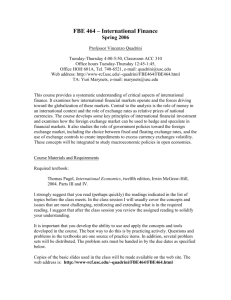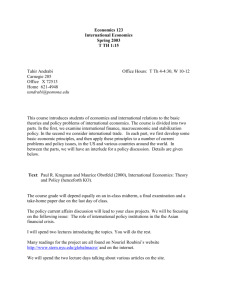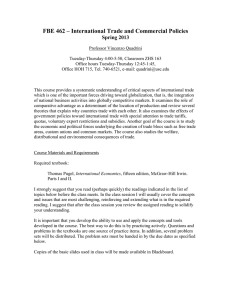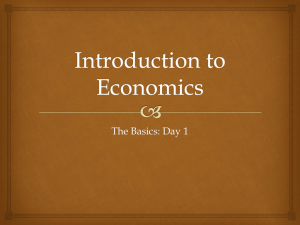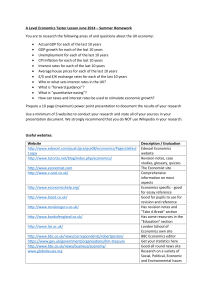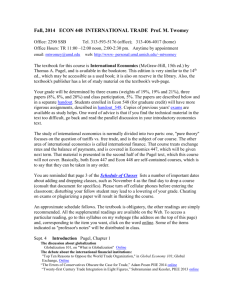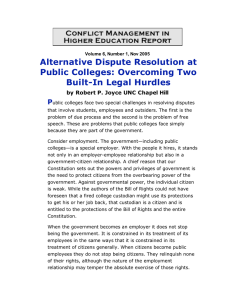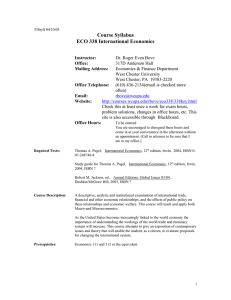econ global fall 2011 outline
advertisement
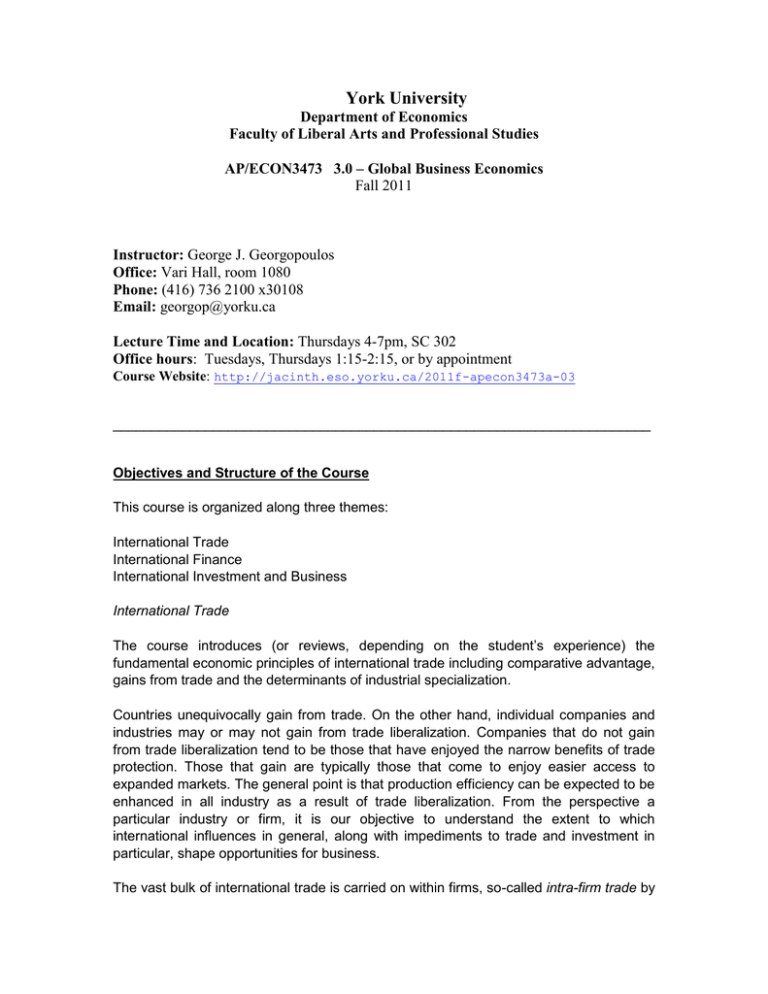
York University Department of Economics Faculty of Liberal Arts and Professional Studies AP/ECON3473 3.0 – Global Business Economics Fall 2011 Instructor: George J. Georgopoulos Office: Vari Hall, room 1080 Phone: (416) 736 2100 x30108 Email: georgop@yorku.ca Lecture Time and Location: Thursdays 4-7pm, SC 302 Office hours: Tuesdays, Thursdays 1:15-2:15, or by appointment Course Website: http://jacinth.eso.yorku.ca/2011f-apecon3473a-03 ______________________________________________________________________ Objectives and Structure of the Course This course is organized along three themes: International Trade International Finance International Investment and Business International Trade The course introduces (or reviews, depending on the student’s experience) the fundamental economic principles of international trade including comparative advantage, gains from trade and the determinants of industrial specialization. Countries unequivocally gain from trade. On the other hand, individual companies and industries may or may not gain from trade liberalization. Companies that do not gain from trade liberalization tend to be those that have enjoyed the narrow benefits of trade protection. Those that gain are typically those that come to enjoy easier access to expanded markets. The general point is that production efficiency can be expected to be enhanced in all industry as a result of trade liberalization. From the perspective a particular industry or firm, it is our objective to understand the extent to which international influences in general, along with impediments to trade and investment in particular, shape opportunities for business. The vast bulk of international trade is carried on within firms, so-called intra-firm trade by transnational enterprise. More than 75 percent of trade in manufactured and processed goods is intra-firm trade. In light of the overwhelming importance of intra-firm trade, and also in view of the relevance for transnational corporate strategy and management, in this course we extend and adapt the traditional trade model to better understand the connections between cross-border investment and international trade including how these connections reflect multinational corporate strategy. Current issues in international trade addressed in the course include the multilateral negotiations at The World Trade Organization and the increasingly regional focus of trade liberalization – NAFTA, European Union, ASEAN and the FTAA. We also examine a number of specific current issues in international business including trade dispute mechanisms, trade in services (with special emphasis on financial services), international aspects of competition policy and the so-called “new protectionism”. International Finance We include a selective introduction to international finance. This section of the course includes a critical examination of the parity conditions in international finance. The parity conditions underlie modern explanations of the determinants of exchange rates as well as most models of international interest arbitrage, the cost of capital of multinational enterprise, and foreign exchange hedging techniques. Managerial aspects of international finance dealt with in the course include managing foreign exchange risk and the cost of capital for multinational enterprise. International Investment and Business The vehicle for international corporate investment is multinational enterprise. Multinationals engage in foreign direct investment – the international transfer and management of capital, technology and production. This course examines the economic motives for foreign direct investment with a focus on the opportunities and risks involved. Special attention is directed to restrictions, regulations and policies that sovereign countries impose on foreign direct investment. We also look at the strategies taken by managers of international businesses when faced with challenges from venturing into overseas markets. th Recommended Text : Thomas A. Pugel, International Economics, 13 McGraw-Hill Irwin 2007 Evaluation Mid-term October 20 50 Final Exam T.B.A. 50 Toronto: Missed Midterm Students may miss an assignment or midterm test due to illness, domestic affliction, or in the case of part time students, work commitments, without academic penalty providing the appropriate documentation is received and approved in a timely manner. There will be no makeup for the midterm. Appropriate documentation is required if you miss the midterm, where the weight will then be allocated to the final exam. Course Work & Academic Honesty Lecture Material and Schedule Along with the readings below, I will be posting lecture slides and other course material on the Quickr Portal. Please visit this site regularly (at least twice a week) for recent postings and announcements. Lecture 1. Introduction, Course Organization, Evaluation Pugel, Chapter 16, “Payments Among Nations”. The Current Account, The Capital Account Reading: Bank of Canada Review (International Tables). U.S. Current Account Deficit and Global Imbalance. Lecture 2. The Fundamentals of International Economics Topics: Basic Theory of Trade / No Factor Movements Comparative Advantage Gains from Trade, Terms of Trade, The Trade Triangle Factor Intensities & The Composition of Trade, Factor Movements / Convergence Pugel, Chapters 1, 2, 3, 4, 5, 6, Krugman, Economist, April 2009 “The elusive link between trade and wage inequality” Hufbauer, Gary C. and J.J. Schott (1998). “North American Economic Integration: 25 st Years Backward and Forward”, Canada in the 21 Century; Industry Canada Research Publications Program, Number 3, November Items 3 and 4 above can be located at … http://strategis.ic.gc.ca/sc_ecnmy/mera/engdoc/02e.html Lecture 3. Trade Policies and Major Initiatives in Economic Liberalization NAFTA, European Union, World Trade Organization Pugel, Chapters 8,9,10, 11,12, 14 “Globalisation and trade”, The Economist, March 2009 Case: Toyota and the EU The WTO Ten Years After Daniel Schwanen “Trading Up: The Impact of Continental Integration on Trade, Investment and Jobs in Canada”, C.D.Howe Institute, Toronto http://www.cdhowe.org/pdf/Sch-01.pdf Antweiler, Werner and Daniel Trefler (2002). “Increasing Returns and All That: A View From Trade”, American Economic Review, Vol 92, No 1, March, pp; 93-119 Hints for Studying: What we want to achieve in today and extending into next week’s session is a clear understanding of the economic and industrial effects of interventions in trade – oldfashioned interventions such as tariffs as well as newer forms of intervention including export subsidies. We develop a framework that despite its simplicity has substantial explanatory power. The fundamental idea is that interventions in trade distort prices of traded goods – producers adjust to the distorted prices and consumers in different places pay different prices for similar products and services. We will address these issues through examples, examples, examples in reference, for instance, to steel, agriculture, aircraft, softwood lumber, textiles & shoes and financial services. One of the more important issues that we explore in these classes is that the underlying economics of production – economies of scale in particular but also the incentives for non-competitive, collusive behaviour – have significant effects on the composition, volume and directions of trade. This anticipates our discussion of competition policy later in the course. By the end of these classes, you will have a solid understanding of why nations intervene in trade, the consequences of such interventions and why nations work together to find ways of reaching mutual, enforceable agreements to dismantle barriers to trade and international investment. One objective from these cases is to have you come away with an understanding of the WTO process of dispute resolution and the structure of remedies. Following this class you will have a clear understanding of the extent to which export promotion via subsidized finance is permitted within the rules of the WTO as well as the criteria for identifying violation of those rules Lecture 4. Canada’s Economy – Competitiveness, Trade Composition and Evolutionary Patterns Monetary Policy Report, Bank of Canada Executive Summary: Foreign Exchange Hedging by Canadian Corporate Accounts, Bank of Canada website “The loonie takes wing” Economist, Sept. 27 2007 “Sharpening Canada’s Competitive Edge”, Industry Canada, 2007 “Compete to Win”, Government of Canada, June 2008 Trefler, Daniel (2000). “The Long and the Short of The Canada-U.S. Free Trade Agreement”, Industry Canada Research Program – Perspectives on North American Free Trade, Paper Number 6 Summary … http://strategis.ic.gc.ca/epic/internet/ineasaes.nsf/vwapj/micro200102e.pdf/$FILE/micro200102e.pdf October 20, 2011: Mid-term Examination Lecture 5 . The Strategy of International Business This section looks at how managers devise strategies to engage international markets in ways that sustain the company’s growth and boost profitability. “Shopping all over the world,” Economist, 1999 Rangan, “Seven myths of globalization,” Mastering Strategy, 1999 Porter, “The Competitive Advantage of Nations,” Harvard Business Review, 1990 Case Study: Zara Fashion Lecture 6. Outsourcing/Offshoring and Global Supply Chain Management “Outsourcing slow to catch on in Canada”, Financial Post, Oct. 20, 2007 “Hello, India? I Need Help with my Math”, New York Times, Oct. 31, 2007 “Opposite headings? Why both Boeing and Airbus are grumbling about their supply chains”, Economist, Dec. 6th, 2007 “Relocating the Back Office”, The Economist, Dec. 13, 2003 Other Sources: “Global Supply Chains: An Exploratory Survey of Management Practice and Challenges”. Research paper, global production.com . Case Study: Nike in China Lecture 7. Foreign Direct Investment: Theory, Strategy, Policy Pugel, Chapter 15 “Cross Border M&As: Does the Exchange Rate Matter?”, George J. Georgopoulos Video: Is Walmart Good for Amerca? Other sources: “Access to Foreign R&D Should Not Undermine Domestic R&D Efforts”, Walid Hejazi Hejazi, Walid and A.E. Safarian (2000). “Modeling Links Between Canadian Trade and Foreign Direct Investment”, Industry Canada, Research Program – Perspectives on North American Free Trade, Paper Number Lecture 8. Introduction to International Finance Topics covered: Markets for Foreign Exchange; The International Parity Conditions. Pugel, Chapters 16 - 19 Eun, Resnick & Brean, International Financial Management, Chapter 5. “Carry on Living Dangerously”, The Economist, Feb 8 2007 A few years ago the most pressing issue in international finance was the exchange rate turbulence associated with, for example, the Asian Financial Crises. That issue has largely subsided, although there is continuing concern about the possibility of recurrence in Asia or elsewhere, hence the widespread attention to “international financial architecture”. Today, perhaps the most interesting and perplexing issue is the relations between the Euro and the US dollar. Another serious issue concerns the value of China’s yuan which, until recently, was pegged to the US dollar. Lecture 9. The Global Financial Crisis, 2007-2009 -Reinhart, V. , “A Year of Living Dangerously: The Management of the Financial Crises in 2008”, Journal of Economics Perspectives, Winter 2011, Vol. 25, No.1. Mishkin, F., “Over the Cliff: From Subprime to the Global Financial Crisis”, Journal of Economics Perspectives, Winter 2011, Vol. 25, No.1. Rajan, R.G., “Has Financial Development Made the World Riskier?”, The Greenspan Era: Lessons for the Future, pp. 313-69. Kansas City: Federal Reserve Bank of Kansas City, 2005. Thomas C. Baxter, Jr. “Too Big to Fail: Expectations and Impact of Extraordinary Government Intervention and the Role of Systemic Risk in the Financial Crisis” , Sept 1. 2010. New York Federal Reserve Bank, http://www.newyorkfed.org/newsevents/speeches/2010/bax100901.html Thomas C. Baxter, Jr., “ What the Fed did and Why”, June 2010, New York Federal Reserve Bank, http://www.newyorkfed.org/newsevents/speeches/2010/tra100625.html Lecture 10. Foreign Exchange Risk and Exposure Pugel, Chapters 18 - 20 Bodnar, Gordon, “Exchange Rate Exposure and Market Value”, in Mastering Risk: The Complete Finance Companion, London: Pitmen Press for The Financial Times, 1998, pp.331-319 “Management of Transaction Exposure”, Eun, Resnick, Brean: International Financial Management: Chapter 13

